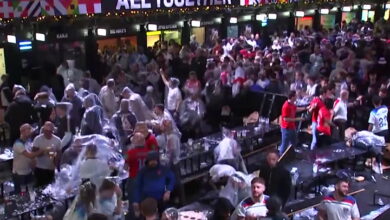Taiwan’s Matsu Islands prepare for a possible China invasion: ‘I don’t want to die, but we have to fight’

Sunlight glistens on the deep blue water like flakes of gold; black-headed gulls wheel in circles over slow sailing fishing trawlers and palm fronds sway in a gentle breeze on the shoreline. The seas around Matsu Island are a picture of tranquility.
The calm of the afternoon is suddenly shattered by heavy gunfire – the sound of Taiwanese artillery carrying out drills, and a reminder that the approaches to these isles will be the “kill zone” in the first line of defence against the invasion long-threatened by China.
Lee, a 30-year-old serving army sergeant, insists that Taiwanese forces will be ready if a conflict begins. His father lives in Shanghai, but that will not, he says, affect his resolve to resist Chinese forces if and when the time comes.
Lee, who asks for his full name not to be published, joined as a volunteer five years ago because “It is our duty as men to serve our country. We don’t want a war, some people in the forces have families in China, like me. But that is not something we can afford to think about when we have to defend Taiwan.
“It will not be a surprise if China attacks us; if it happens, it happens. I don’t want to die, my friends don’t want to die. But you need to accept death if you are a soldier.”
Tensions have risen sharply in the Indo-Pacific as confrontations continue between China and its neighbours backed by international allies. Taiwan, which Beijing wants to unify with the mainland by force if necessary, has become a focal point. There are elections next week in which the issue of independence from China is a key theme.
While the Ukraine war has reached a bloody stalemate on the icy frontlines, and international consternation rises over the staggering toll of civilian lives in Israel’s Gaza assault, what happens in Taiwan is likely to emerge as the first geopolitical crisis of this year.
Beijing has ratcheted up aggressive military exercises around Taiwan with its fighter jets and warships infringing Taiwan’s air and naval space as the election campaign has stepped up. President Xi Jinping has declared that China’s armed forces will be ready for a full-scale invasion by 2027 and its commanders maintain that preparations are on schedule. In his latest New Year’s Eve address Xi claimed that Taiwan would “surely be reunified” with China.
China’s overall military activity has increased as it carries out a vast expansion of its forces. It rises in scale each time Western naval ships – including American, British, French and Australian – carry out “freedom of navigation” voyages in international waters Beijing claims as its own. There are also spikes when the international community shows solidarity with Taiwan, such as the visit of then US House of Representative speaker Nancy Pelosi visited Taiwan last year. Beijing reacted by launching barrages of missiles into waters surrounding Taiwan and starting a major military exercise.
Asymmetric warfare, cyber-attacks and disinformation campaigns have also escalated against Taiwan as the polls get closer. The main targets have been the ruling Democratic Progressive Party (DPP), which is campaigning on a theme of Taiwan sovereignty, as well as sections of the media, civil rights activists, students and artists groups. In effect all who are deemed to be enemies of the Chinese Communist Party (CCP) and its autocratic policies.
Two underwater Internet cables were cut by Chinese ships a few months ago, effectively cutting off Matsu from the outside world, with flights to the island from the rest of Taiwan, and public and private life on the island disrupted. It was viewed as a warning of what to expect on a much wider scale if Taiwan seeks to strike a path towards independence.
Matsu and Kinmen, another island between China and Taiwan, experienced fierce fighting between the communist forces under Mao Dezung and the nationalist army of Chiang Kai-Shek as retreated from the mainland to Taiwan at the end of the civil war.
The nationalists turned the two islands into fortresses, bristling with weapons and thousands of troops. Barricades and mines were placed on the beaches, artillery dug into hills, anti-submarine netting laid into coastal waters and deep bunkers dug into the ground.
A series of vast underground passageways were built on Matsu – the biggest number of military tunnels in the world – in preparation for next war, with waterways where supply vessels and attack crafts were kept hidden.
For ten years from 1949, the two forces clashed around the islands, leaving hundreds dead and several thousand injured. Intermittent Chinese shelling continued for the next two decades before an eventual ceasefire was followed by partial de-escalation and withdrawal of most of the forces by Taiwan.
Some of the weapons used during previous fighting on Matsu
A gradual thaw in relations led to Chinese visitors coming to the islands and islanders going to the mainland. Some families migrated to new lives across the Strait.
Some of these fortifications are now tourist attractions. Jiahao Yang is showing his grandsons, aged four and six, one of the Matsu tunnels which has been opened to the public.
As a young officer in the Taiwanese army he had witnessed the final stages of their construction. “It was dangerous work building these tunnels. There was one time when about 50 soldiers were killed, they had taken a break for lunch when big rocks fell on them. There were individual deaths quite regularly with walls collapsing and also with the detonations which took place”, he recalls. “But the threat from China was very real and the general feeling was these sacrifices had to be accepted.”
Captain Yang was on the receiving end of regular Chinese bombardment. “That was mainly in Kinmen. They used heavy artillery and missiles, but they were quite inaccurate. So they did a lot of damage, mainly to civilians rather than us,” he says.
Taiwanese soldiers operating tanks during a drill
One of the tunnels dug underneath Matsu





